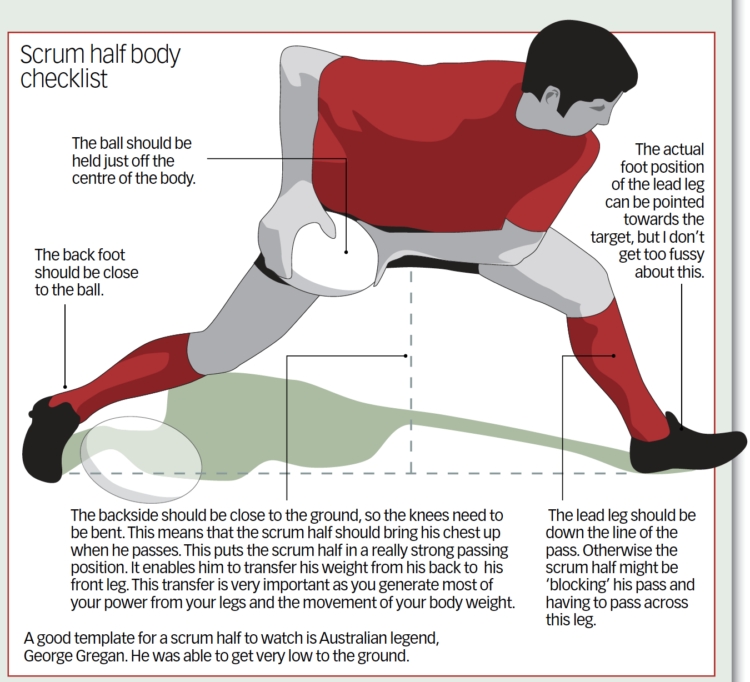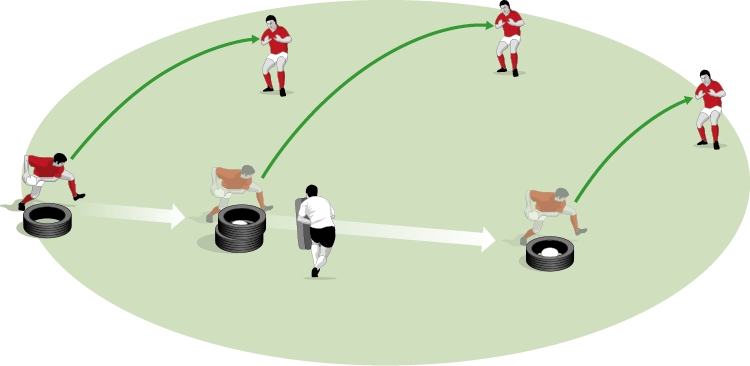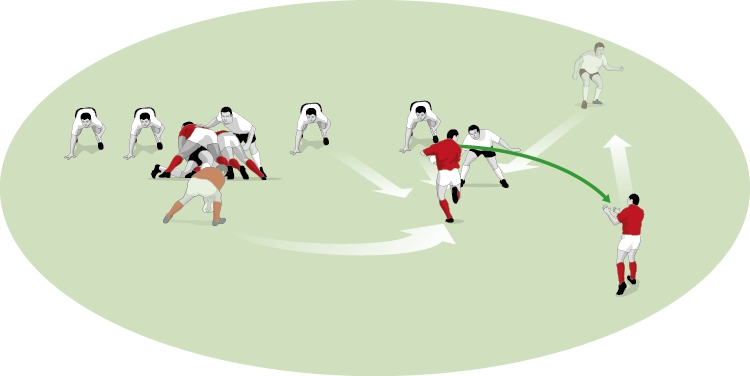More efficient half back training and tactics
Warm-Upsby Jamie Hamilton
How to coach 9s to be better passers and decision makers.
When I take the half backs for individual coaching, I aim to set up game-related drills. I like to check that I am not doing a drill for the sake of a drill.
A typical session when I worked with someone like All Black 9 Andy Ellis was to start with ‘work ons’ – these are techniques identified as areas to improve upon.
From our analysis of games and training, I will be looking at certain aspects of the scrum half pass. So, we might be using a simple exercise like a one handed pass off the ground. This enables me to check that the body position is correct.

I will ensure that the feet are properly positioned. I am also a firm believer that the right height is generated when the player’s bottom is low to the ground.
We might use a rugby ball for this sort of work or a soccer ball. This helps accentuate the hand action. I want the hand to be whipping over the ball. This comes in one movement, so the ball is picked up, but whipped away.
Because the ruck area can be so heavily contested, the scrum half has to be able to pick and pass. This also makes him a threat.
When I was at the Crusaders, we liked the scrum half to run a little with the ball when we are going forward to interest defenders. We rarely got the scrum half to dive pass, because he ends on the ground which puts him out of the game.
The fly half (10) should vary his depth from the ruck or set pieces depending on the play we are using, the ball and the defence in front of him. If he is going to kick, then he will naturally stand a little deeper.
If we are running the ball, then he will take a couple of steps onto the ball, so he can take the ball to the line. The general depth that he starts at is mainly dependent on the team we are playing.
Against the blitz 10 will stand deeper. Against a drift defence, we want the 10 to bring the ball up to the defence, to hold them.
We might run a play where the midfield (10, 12 and 13) is flat. 10 passes to 12 who passes behind 13 to the blindside winger. The idea is to prevent the opposition defence drifting across the pitch.

With scrum halves having to pick the ball out of the mess at the tackle, I like to use tyres to simulate these situations. I place them in a pattern across the pitch to replicate certain patterns of play. I can spread the tyres out to mirror a sequence of plays, which keeps the ball moving the same way.
Or I can stack tyres to make the ball more difficult to clear. We can put in a ruck pad holder to put pressure on the scrum half as he gathers the ball.
We have what we call ‘taxi lines’ where the forwards run onto the pass of the 9. Both 9 and the forwards need to understand when and where runs will be made. This prevents forwards running onto the ball too early.

If 9 is going to run, I want him to get outside the second defender from the ruck. If he can get outside him the third defender has to make a decision. The forwards will then aim at the gaps. The third defender out from the ruck is forced into making a decision.
Does he go with the 9 or shift onto a forward? If that defender steps in, then 9 can release a forward through the gap, or half gap.
Generally you don’t want the 9 running when there is slow ball from the ruck. Teams are not committing at the ruck in these situations, so it is better to pass away than run.
At our level, 9s do not always have to call that they are going to run. Forwards should be able to read the situation and react if the ball is quick or slow. Lower down, then I would expect a call. We don't have that many moves from the edges of rucks.
We have variations of themes on the plays with the scrum half running and popping the ball to forwards coming from various angles.
When I take the half backs for individual coaching, I aim to set up game-related drills. I like to check that I am not doing a drill for the sake of a drill.
A typical session when I worked with someone like All Black 9 Andy Ellis was to start with ‘work ons’ – these are techniques identified as areas to improve upon.
From our analysis of games and training, I will be looking at certain aspects of the scrum half pass. So, we might be using a simple exercise like a one handed pass off the ground. This enables me to check that the body position is correct.

I will ensure that the feet are properly positioned. I am also a firm believer that the right height is generated when the player’s bottom is low to the ground.
We might use a rugby ball for this sort of work or a soccer ball. This helps accentuate the hand action. I want the hand to be whipping over the ball. This comes in one movement, so the ball is picked up, but whipped away.
PICKING AND PASSING
Because the ruck area can be so heavily contested, the scrum half has to be able to pick and pass. This also makes him a threat.
When I was at the Crusaders, we liked the scrum half to run a little with the ball when we are going forward to interest defenders. We rarely got the scrum half to dive pass, because he ends on the ground which puts him out of the game.
DEPTH OF THE FLY HALF
The fly half (10) should vary his depth from the ruck or set pieces depending on the play we are using, the ball and the defence in front of him. If he is going to kick, then he will naturally stand a little deeper.
If we are running the ball, then he will take a couple of steps onto the ball, so he can take the ball to the line. The general depth that he starts at is mainly dependent on the team we are playing.
Against the blitz 10 will stand deeper. Against a drift defence, we want the 10 to bring the ball up to the defence, to hold them.
We might run a play where the midfield (10, 12 and 13) is flat. 10 passes to 12 who passes behind 13 to the blindside winger. The idea is to prevent the opposition defence drifting across the pitch.
USING TYRES IN TRAINING

With scrum halves having to pick the ball out of the mess at the tackle, I like to use tyres to simulate these situations. I place them in a pattern across the pitch to replicate certain patterns of play. I can spread the tyres out to mirror a sequence of plays, which keeps the ball moving the same way.
Or I can stack tyres to make the ball more difficult to clear. We can put in a ruck pad holder to put pressure on the scrum half as he gathers the ball.
BRINGING IN THE FORWARDS
We have what we call ‘taxi lines’ where the forwards run onto the pass of the 9. Both 9 and the forwards need to understand when and where runs will be made. This prevents forwards running onto the ball too early.

If 9 is going to run, I want him to get outside the second defender from the ruck. If he can get outside him the third defender has to make a decision. The forwards will then aim at the gaps. The third defender out from the ruck is forced into making a decision.
Does he go with the 9 or shift onto a forward? If that defender steps in, then 9 can release a forward through the gap, or half gap.
The scrum half v the ruck defence
| Ruck speed | Option 1 | Option 2 |
|---|---|---|
| Fast ball | Pass off the ground if possible to the backs | Since the ruck defence is not properly in place, the scrum half can pick and run before releasing a forward or the backs |
| Slow ball | Pass the ball. The ruck defence will be ready to take out the scrum half | Leave it to the forwards |
Generally you don’t want the 9 running when there is slow ball from the ruck. Teams are not committing at the ruck in these situations, so it is better to pass away than run.
At our level, 9s do not always have to call that they are going to run. Forwards should be able to read the situation and react if the ball is quick or slow. Lower down, then I would expect a call. We don't have that many moves from the edges of rucks.
We have variations of themes on the plays with the scrum half running and popping the ball to forwards coming from various angles.
Newsletter Sign Up
Coaches Testimonials

Gerald Kearney, Downtown Las Vegas Soccer Club

Paul Butler, Florida, USA

Rick Shields, Springboro, USA

Tony Green, Pierrefonds Titans, Quebec, Canada
Subscribe Today
Be a more effective, more successful rugby coach
In a recent survey 89% of subscribers said Rugby Coach Weekly makes them more confident, 91% said Rugby Coach Weekly makes them a more effective coach and 93% said Rugby Coach Weekly makes them more inspired.
Get Weekly Inspiration
All the latest techniques and approaches
Rugby Coach Weekly offers proven and easy to use rugby drills, coaching sessions, practice plans, small-sided games, warm-ups, training tips and advice.
We've been at the cutting edge of rugby coaching since we launched in 2005, creating resources for the grassroots youth coach, following best practice from around the world and insights from the professional game.












